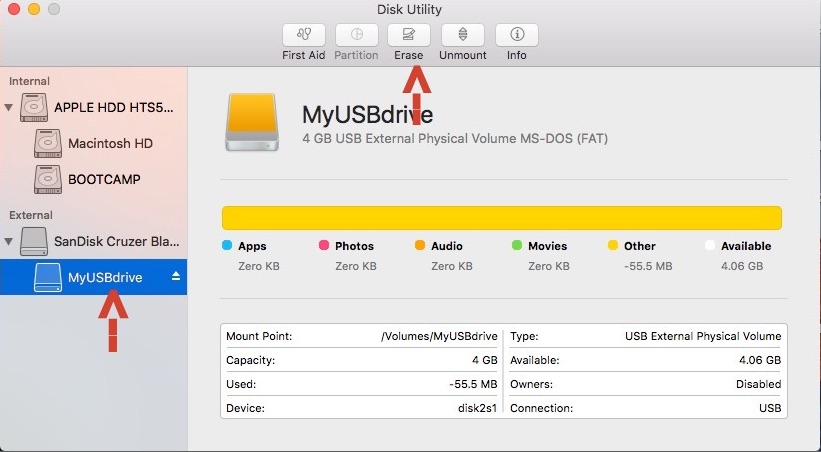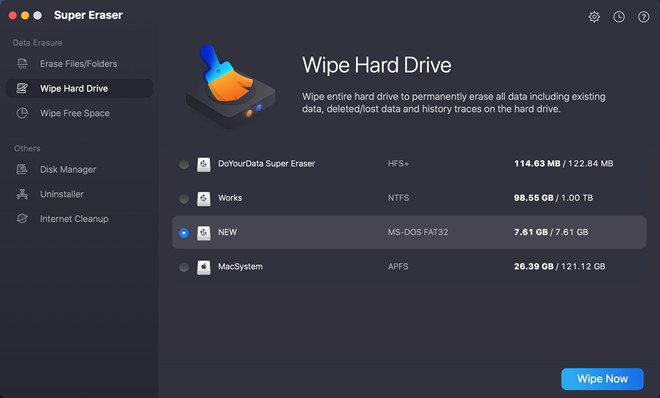What is the best file system for USB or external hard drive on Mac?
First, note the number of the disk in the disk management window. For example, in the screenshot below, the Mac-formatted drive is Disk 2. Next, open a Command Prompt window as administrator. To do this on Windows 8 or Windows 7, press the Windows key once, type cmd, and press Ctrl+Shift+Enter.
Windows and Mac OS X use different file systems. Windows uses NTFS and Mac can't write files to volumes with NTFS format.

So, if you want to use a USB flash drive or an external hard drive with NTFS format on Mac, you should first reformat the devices to the Mac OS Extended file system. It is the best way to ensure full Mac compatibility of a new external hard drive or flash disk.
Usually, FAT32 which can be read and wrote on Mac is recommended for maximum compatibility. And if you need to transfer files larger than 4 GB between Macs and Windows computers, exFAT or MS-DOS (FAT) is better.
How to format USB flash drive or external hard drive for Mac
But how can you format USB flash drive or external hard drive for Mac? Don’t worry! This page will show you two ways to do this job:
Format USB or external hard drive for Mac using Mac disk utility
Format USB or external hard drive for Mac on Windows PC using third-party USB format tool
Now, you can follow these two solutions to format any hard drive, flash drive, USB drive, SSD or any other external storage drive so as to make them work on your Mac now.
Method 1. Format USB or external hard drive for Mac using Mac Disk utility

Windows offers users built-in disk management tool to create, delete, resize, merge and format partitions. You can try the following steps to format USB or external hard drive for Mac with Disk Utility on Mac.
- 1. Connect the USB or external hard drive to your Mac computer.
- 2. Launch the Disk Utility by clicking 'Applications' > 'Utilities'.
- 3. Locate and click on your USB or external hard drive in Disk Utility and then click on 'Erase'.
- 4. Next to 'Format', click the contextual menu and select 'Mac OS Extended (Journaled)'.
- 5. Reset the drive name and click 'Erase', confirm the operation on the next pop-up window.
- Wait for the process to complete and then you'll get compatible HFS+ file system on your external hard drive or USB, which will make your device compatible and workable on your Mac.
Method 2. Format USB or external hard drive for Mac using third-party USB format tool on a Windows PC
If you need a simpler format tool to format USB or external hard drive to FAT32 to make them work on Mac, you can apply a third-party format tool to format them on Windows PC. EaseUS partition software is a popular disk partition management tool which is available for all hard disk related jobs such as format disk partition, extend system partition, settle low disk space problem.
Now you can try it to format USB or external hard drive on your Windows PC by following the steps below. If you stored important data on the USB or external hard drive, you can try this tool to convert NTFS to FAT32 without formatting.
Format Usb For Mac And Windows Disk Utility
Step 1: Launch EaseUS Partition Master, right-click the partition on your external hard drive/USB/SD card which you want to format and choose the 'Format' option.
Step 2: Assign a new partition label, file system (NTFS/FAT32/EXT2/EXT3), and cluster size to the selected partition, then click 'OK'.
Step 3: In the Warning window, click 'OK' to continue.
Step 4: Click the 'Execute Operation' button in the top-left corner to review the changes, then click 'Apply' to start formatting your external hard drive/USB/SD card.
After this, you can connect your external hard drive/USB to Mac computer and use it to save data by then.
Since the PC and Mac are two different operating systems, they use different file systems. By default, Macs use HFS, while PCs use NTFS, which are not compatible with each other. If you plan on using an external drive with both Macs and PCs, you should format the disk with the exFAT file system instead.
You can format the drive on your Mac or Windows computer.
How to format a USB drive as exFAT on Mac
So how do you know if your USB drive is in the correct format? You do not need to do anything special on the 'Disk Utility' - simply insert the USB drive and open Finder. Right-click the drive icon in the Finder sidebar (or on the desktop) and select Get Info. You will see the drive's file system shown on the right “Format”.
Formatting a drive will erase it completely, so make sure you have everything backed up that you want to keep. To format a drive on a Mac, you'll need the built-in Disk Utility application.
Go to Open Disk Utility, which is located under Applications in the Finder menu. If you have a USB flash drive inserted in your Mac, you can see it under the External in the Disk Utility. Select your flash drive from the list. Go to the Erase tab. You will be asked to provide the disk name and then select the file system as exFAT.
Then select the default GUID Partition Map (GPT) scheme. Click the Erase button when you are done and the Disk Utility will format your disk with the settings you specified. This will erase all the files on the drive.
You're now done. Be sure to eject the disk before you remove it from your Mac.
How to format a USB flash drive as exFAT on Windows PC
There are several ways to format drive in Windows PC, you can do that in This PC or in Disk Management.
Note: If you have important data on your USB flash drive, you should backup your drive before formatting it.
Option 1: Format a USB drive as EexFAT in This PC.
Press Windows logo key + E to open File Explorer. Right-click on the drive you want to format, click on Format. Under File system box, select exFAT for this drive. Then click Start button to go on.
Format Usb Drive On Mac
Option 2: Format a USB drive as EexFAT in Disk Management.
Press Win+X, then hit K key to open Disk Management (diskmgmt.msc).
Right-click on the drive you want to format, select Format to see the list of configurations including file system. Select exFAT for this drive. Then click OK button to go on.
Related Articles
Format Usb On Mac To Work On Windows
- How to Backup an External Hard Drive before Formatting It
- How to Create and Format a Hard Disk Partition in Windows 10
- Check and Repair Bad Sectors in USB Flash Drive
- Fix USB Device Can't be Recognized by Computer
- Recover Hidden Files in Virus-attacked USB Drive
- Password Protect a USB Flash Drive on Mac without Erasing Data